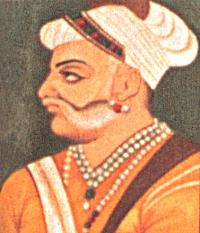
Bappa Rawal was a king of the Mewar kingdom in Rajasthan, India. The chronicles describe him as a member of the Guhila Clan, and some of them consider him to be the founder of the Guhila dynasty. He is credited with repelling the Arab invasion of India. He was renowned with the name "Maharaja Kaalbhoj", which meant a praise for his extremely powerful arms. He is identified as the ruler of the Guhila dynasty, and called by the names Kalabhoja, Shiladitya, and Khumana.
Maharana Hammir Singh (1302–1364), or Hammir, was a 14th-century ruler of Mewar in present-day Rajasthan, India. Hammir Singh, was a scion of the cadet branch Rana of the Guhila dynasty, who regained control of the region, re-established the dynasty after defeating the Tughlaq dynasty, and captured present-day Rajasthan from Muslim forces of Delhi and became the first of the 'Rana' branch to become the King of Mewar with title of Maharana. Hammir also became the progenitor of the Sisodia clan, a branch of the Guhila dynasty, to which every succeeding Maharana of Mewar has belonged.

The Chittorgarh, also known as Chittod Fort, is one of the largest living forts in India. It is a UNESCO World Heritage Site. The fort was the capital of Mewar and is located in the present-day city of Chittorgarh. It sprawls over a hill 180 m (590.6 ft) in height spread over an area of 280 ha above the plains of the valley drained by the Berach River. The fort covers 65 historic structures, which include four palaces, 19 large temples, 20 large water bodies, 4 memorials and a few victory towers.

Panna Dhai was a 16th-century nursemaid to Udai Singh II, the fourth son of Rana Sanga. She was a Rajput of Kheechi clan.

The battle of Haldighati was fought on 18 June 1576 between the Mewar forces led by Maharana Pratap, and the Mughal forces led by Man Singh I of Amber. The Mughals carried the day after inflicting significant casualties on Mewar forces, although they failed to capture Pratap, who reluctantly retreated persuaded by his fellow commanders.

The history of human settlement in the western Indian state of Rajasthan dates back to about 100,000 years ago. Around 5000 to 2000 BCE many regions of Rajasthan belonged as the site of the Indus Valley Civilization. Kalibangan is the main Indus site of Rajasthan, here fire altars have been discovered, similar to those found at Lothal.

The Kingdom of Mewar, also called Medapata, was an independent kingdom that existed in the Rajputana region of the Indian Subcontinent and later became a dominant state in medieval India. The kingdom was initially founded and ruled by the Guhila dynasty followed by the Sisodiya Dynasty. The earliest kingdom was centered around the south-central part of Rajasthan, state of India. It was bordered by the Aravali Range to the northwest, Ajmer to the north, Gujarat, Vagad and Malwa regions to the south and the Hadoti region to the east.
Raimal Singh Sisodia, also known as Rana Raimal, was a Hindu Rajput ruler of Mewar. Maharana Raimal was the son of Rana Kumbha and his Rathore queen, a princess of Idar.

Maharana Amar Singh I, the Maharana ruler of Mewar Kingdom, was the eldest son and successor of Maharana Pratap I.He was the 14th Rana of Mewar,ruling from January 19, 1597 till his death on January 26, 1620.

Maharana Raj Singh I, was the Maharana of Mewar Kingdom and eldest son of Maharana Jagat Singh I. He fought against Mughal Empire and annexed many Mughal territories He participated in Rajput-Mughal War (1679–1707) and defeated the Mughals.

Rana Mokal or Mokal Singh, was the fourth ruler of Mewar Kingdom,the youngest son of Rana Lakha and father of Rana Kumbha of Mewar.
Rana Ratan Singh II was the Maharana of Mewar Kingdom. He was a son of Rana Sanga. He was killed during a war in 1531. He was succeeded by his surviving brother Vikramaditya Singh.
The Guhilas of Medapata colloquially known as Guhilas of Mewar were a Rajput dynasty that ruled the Kingdom of Mewar region in present-day Rajasthan state of India. The Guhila kings initially ruled as Gurjara-Pratihara feudatories between end of 8th and 9th centuries and later were independent in period of the early 10th century and allied themselves with the Rashtrakutas. Their capitals included Nagahrada (Nagda) and Aghata (Ahar). For this reason, they are also known as the Nagda-Ahar branch of the Guhilas.

Rao Ganga was the Rathore Rajput ruler of the Kingdom of Marwar. Rao Ganga ascended to the throne in the year 1515 through the support from his kinsmen and nobles. During his reign, the Rathores consolidated and expanded their rule in eastern Marwar.
Banvir, also known as Banbeer was the ruler of Mewar Kingdom between 1536 and 1540. He was nephew of Rana Sanga, born to his brother Prithviraj and his cocunbine.
Chunda was the eldest son of Maharana Lakha, the ruler of Mewar. He is known in history for his sacrifice of his rights to the throne, to keep his promise. He was the heir-apparent until he renounced his right in favour of the heir born from Hansa Bai, the Rathore princess who was married to Maharana Lakha.
Rawal Jaitrasimha also known as Rawal Jaitra Singh was the ruler of the Guhila dynasty from 1213 to 1252. During his rule, the Guhila Kingdom attained a high political status. Ekalinga Mahatmya mentions his title as Rajakula (Rawal), his own inscriptions call him a Maharajadhiraja.
Samantasimha or Samant Singh was the ruler of the Guhila dynasty during the second half of the 12th century. He succeeded his father Kshemasimha. After the death of the powerful Chaulakya king Kumarapal, Samantsingh successfully invaded Gujarat. He was later deposed from Mewar. He sought refuge in Vagad and established himself there but was soon expelled from there as well.








